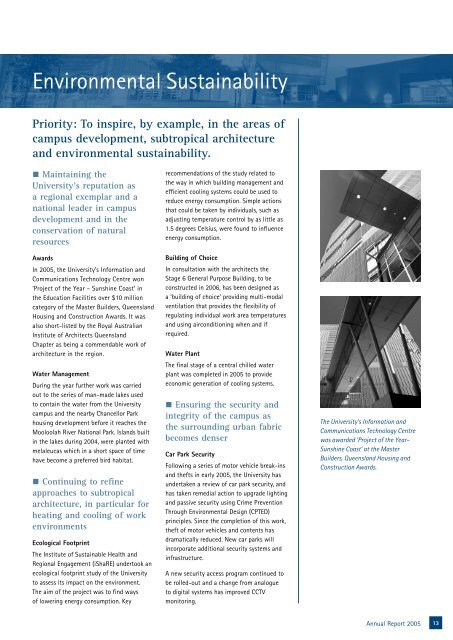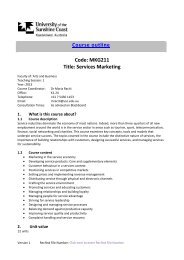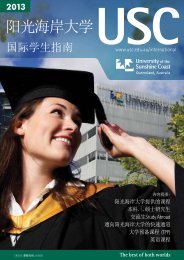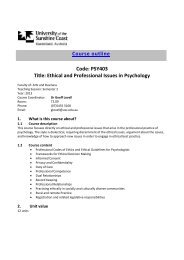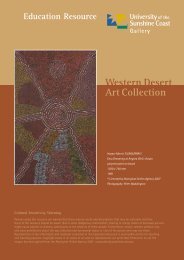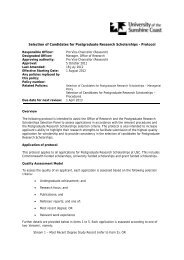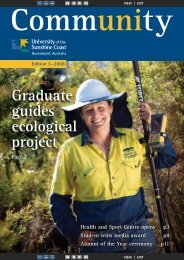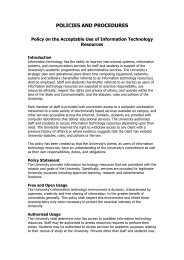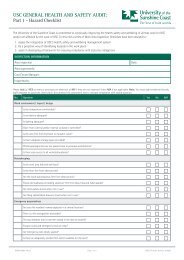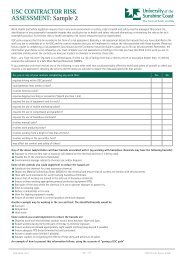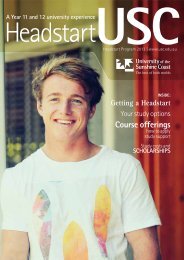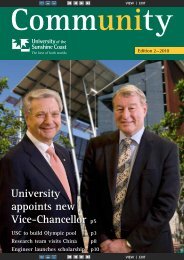Complete 2005 Annual Report (PDF 1.8MB) - University of the ...
Complete 2005 Annual Report (PDF 1.8MB) - University of the ...
Complete 2005 Annual Report (PDF 1.8MB) - University of the ...
Create successful ePaper yourself
Turn your PDF publications into a flip-book with our unique Google optimized e-Paper software.
Environmental Sustainability<br />
Priority: To inspire, by example, in <strong>the</strong> areas <strong>of</strong><br />
campus development, subtropical architecture<br />
and environmental sustainability.<br />
• Maintaining <strong>the</strong><br />
<strong>University</strong>’s reputation as<br />
a regional exemplar and a<br />
national leader in campus<br />
development and in <strong>the</strong><br />
conservation <strong>of</strong> natural<br />
resources<br />
Awards<br />
In <strong>2005</strong>, <strong>the</strong> <strong>University</strong>’s Information and<br />
Communications Technology Centre won<br />
‘Project <strong>of</strong> <strong>the</strong> Year – Sunshine Coast’ in<br />
<strong>the</strong> Education Facilities over $10 million<br />
category <strong>of</strong> <strong>the</strong> Master Builders, Queensland<br />
Housing and Construction Awards. It was<br />
also short-listed by <strong>the</strong> Royal Australian<br />
Institute <strong>of</strong> Architects Queensland<br />
Chapter as being a commendable work <strong>of</strong><br />
architecture in <strong>the</strong> region.<br />
Water Management<br />
During <strong>the</strong> year fur<strong>the</strong>r work was carried<br />
out to <strong>the</strong> series <strong>of</strong> man-made lakes used<br />
to contain <strong>the</strong> water from <strong>the</strong> <strong>University</strong><br />
campus and <strong>the</strong> nearby Chancellor Park<br />
housing development before it reaches <strong>the</strong><br />
Mooloolah River National Park. Islands built<br />
in <strong>the</strong> lakes during 2004, were planted with<br />
melaleucas which in a short space <strong>of</strong> time<br />
have become a preferred bird habitat.<br />
• Continuing to refine<br />
approaches to subtropical<br />
architecture, in particular for<br />
heating and cooling <strong>of</strong> work<br />
environments<br />
Ecological Footprint<br />
The Institute <strong>of</strong> Sustainable Health and<br />
Regional Engagement (iShaRE) undertook an<br />
ecological footprint study <strong>of</strong> <strong>the</strong> <strong>University</strong><br />
to assess its impact on <strong>the</strong> environment.<br />
The aim <strong>of</strong> <strong>the</strong> project was to find ways<br />
<strong>of</strong> lowering energy consumption. Key<br />
recommendations <strong>of</strong> <strong>the</strong> study related to<br />
<strong>the</strong> way in which building management and<br />
efficient cooling systems could be used to<br />
reduce energy consumption. Simple actions<br />
that could be taken by individuals, such as<br />
adjusting temperature control by as little as<br />
1.5 degrees Celsius, were found to influence<br />
energy consumption.<br />
Building <strong>of</strong> Choice<br />
In consultation with <strong>the</strong> architects <strong>the</strong><br />
Stage 6 General Purpose Building, to be<br />
constructed in 2006, has been designed as<br />
a ‘building <strong>of</strong> choice’ providing multi-modal<br />
ventilation that provides <strong>the</strong> flexibility <strong>of</strong><br />
regulating individual work area temperatures<br />
and using airconditioning when and if<br />
required.<br />
Water Plant<br />
The final stage <strong>of</strong> a central chilled water<br />
plant was completed in <strong>2005</strong> to provide<br />
economic generation <strong>of</strong> cooling systems.<br />
• Ensuring <strong>the</strong> security and<br />
integrity <strong>of</strong> <strong>the</strong> campus as<br />
<strong>the</strong> surrounding urban fabric<br />
becomes denser<br />
Car Park Security<br />
Following a series <strong>of</strong> motor vehicle break-ins<br />
and <strong>the</strong>fts in early <strong>2005</strong>, <strong>the</strong> <strong>University</strong> has<br />
undertaken a review <strong>of</strong> car park security, and<br />
has taken remedial action to upgrade lighting<br />
and passive security using Crime Prevention<br />
Through Environmental Design (CPTED)<br />
principles. Since <strong>the</strong> completion <strong>of</strong> this work,<br />
<strong>the</strong>ft <strong>of</strong> motor vehicles and contents has<br />
dramatically reduced. New car parks will<br />
incorporate additional security systems and<br />
infrastructure.<br />
A new security access program continued to<br />
be rolled-out and a change from analogue<br />
to digital systems has improved CCTV<br />
monitoring.<br />
The <strong>University</strong>’s Information and<br />
Communications Technology Centre<br />
was awarded ‘Project <strong>of</strong> <strong>the</strong> Year-<br />
Sunshine Coast’ at <strong>the</strong> Master<br />
Builders, Queensland Housing and<br />
Construction Awards.<br />
<strong>Annual</strong> <strong>Report</strong> <strong>2005</strong> 13


